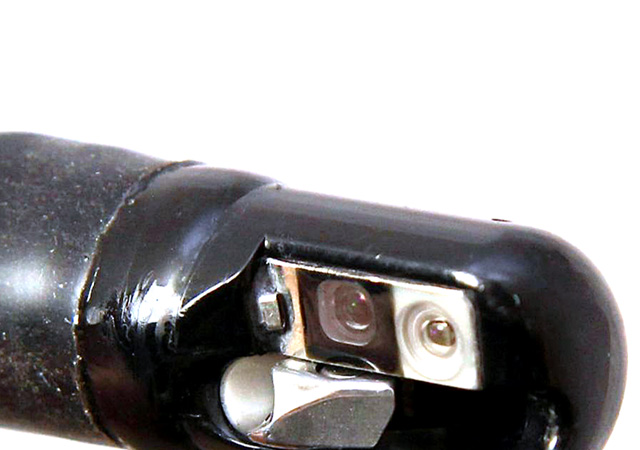Superbug Fears Mount in Texas After Deaths at UCLA
By Gloria Fan
Reporting Texas

The tip of a duodenoscope includes a camera, a light, an air nozzle and an elevator channel to take samples. The complex design of these scopes makes them difficult to clean. Photo courtesy of FDA
Texas hospitals and clinics have reported more than 500 suspected cases of drug-resistant “superbug” infections in the past year, typically caused during endoscopies performed using a sophisticated but hard-to-clean instrument.
Superbugs, a common name for CRE bacteria, are resistant to the latest antibiotics and kill nearly half of all infected patients, according to the federal Centers for Disease Control and Prevention.
In March, the Ronald Reagan UCLA Medical Center in Los Angeles reported seven confirmed cases and two deaths from CRE, triggering nationwide concern about the medical procedures that spread these infections.
“CRE is an organism that’s resistant to some of the best antibiotics,” said Dr. Alfred Lea, the infectious diseases clinic director at the University of Texas Medical Branch in Galveston. “If you’re healthy, the likelihood of you getting the superbug is extremely low. The likelihood is different if you’re a patient with a more serious case.”
Infections can occur when doctors insert fiber-optic instruments called duodenoscopes through patients’ mouths into their bodies. Tiny cameras in the scopes allow doctors to examine the small intestine and ducts in the liver, pancreas and gallbladder. The equipment is used in 500,000 procedures a year, typically in hospitals, according to the U.S. Food and Drug Administration.
“Doctors who use these scopes are usually looking for something pretty serious, such as a gallstone or a tumor,” Lea said.
But the scopes are also difficult to clean, increasing the chances of infection. The earliest CRE infections were reported in 2011.
“There are two parts to cleaning these scopes. You have to first clean it, and then you have to sterilize it,” Lea said. “This is not a piece of equipment that you can just put into an incubator, heat it up and then have it cleaned in a few minutes.”
After the UCLA outbreak, the FDA issued new standards for cleaning and reprocessing duodenoscopes, changing guidelines that had been in place since 1996.
“The current guidance provides more detailed recommendations regarding use of cleaning and lubricating agents, visual inspection and drying, which were not addressed in the 1996 guidance,” said Jennifer Dodson, an FDA press officer.
Manufacturers issue their own cleaning guidelines.
All three manufactures – Fujifilm, Olympus and Pentax – have redesigned their scopes to make cleaning easier and reduce the likelihood of spreading bacteria from one patient to another. The FDA has approved the designs from Fujifilm and Pentax, and the new scopes are in use. Olympus still needs FDA approval before it can introduce its redesign.
Olympus is the manufacturer of the scope held responsible for the outbreak at UCLA.
Mark Miller, vice president of corporate and medical communications at Olympus, said this model was particularly difficult to clean. “While all endoscopes, including duodenoscopes, require thorough reprocessing after patient use in order to be safe, the Olympus … requires careful attention to cleaning and reprocessing steps, including meticulous manual cleaning, for effective reprocessing,” he said.
Several states have their own guidelines for cleaning such instruments. Texas does not, but it has advised all hospitals and clinics to follow the new federal standards, said Chris Van Duesen, press officer at the Texas Department of State Health Services. A spokesperson for St. David’s Healthcare confirmed that the center follows all federal recommendations regarding the reprocessing of duodenoscopes. Seton Healthcare Family declined to comment.
In April 2014, Texas made it mandatory for all suspected CRE cases to be reported to the health services department. Among the major counties, 160 probable cases have been reported from Harris County , 29 from Bexar County, six from Dallas County and five from Travis County. None of these cases have been confirmed, Van Duesen said.
Lea said hospitals should undertake extensive measures to deal with CRE cases.
“We will have them go through surveillance cultures, swab them and see what’s there,” Lea said. “If it’s serious, I’ll put them in isolation where we monitor him.”
Treatment is costly and can take 10 days to two weeks. Older antibiotics generally work because the CRE has developed resistance only to newer drugs, Lea said.
The outbreak at UCLA spurred the White House to announce a “national action plan for combating antibiotic-resistant bacteria” in March. The plan aims to cut down CRE infections acquired during hospitalization by 60 percent by the year 2020.